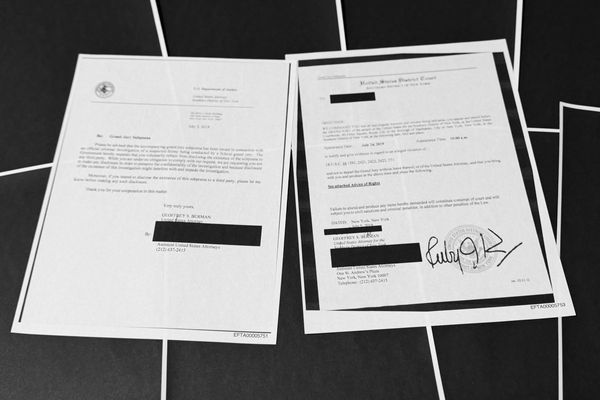
It was a cloudy mid-September Tuesday in New York City, the type when Mother Nature can’t make up her mind whether she wants to rain or not. Still, there was enough color in the back room of Cafe Zaffri to stave off the gloom. There, Ashley Moubayed was hosting her first official New York Fashion Week event for her jewelry brand, Don’t Let Disco. Half a presentation of Moubayed’s spring 2026 collection, half a pop-up beading bar for guests to create their own token.
Seven or so models—a few were members of the 2021-launched brand's small team—wore layered beaded necklaces and tasseled stands from the new collection. Editors, buyers, and voices of the fashion commentariat (I recognized at least four Substack authors I follow) sat at white-tablecloth tables stringing vintage beads, rock crystals, and pearls onto cords. One woman brought her black cat, Pi, with a turquoise Don't Let Disco charm clipped to its collar. The entire event felt like a convention of cool girls just as much as it did a tactile exercise to satisfy your inner child.
The goal of the afternoon was connection: between the guests, when they asked their neighbor for advice on which bead to place next, and between attendees and the jewelry they made. “I like the idea of the customer being involved in the process,” Moubayed, 36, told me on a video call two weeks before her formal NYFW debut. “That's missing from luxury now—people just want something for the face of it or the status that it comes with. But luxury is more than that; it should really be an entire world you’re an active participant in."

In the world of Don’t Let Disco, there's one key tenet to know: a bead is more than just a bauble. “My mission is to elevate the humble bead into the realm of fine jewelry—to get people to understand the stories behind each bead, and to realize that there is a richness and a luxury in these stories,” says Moubayed.
The Bed Stuy, Brooklyn-based designer uses found and secondhand materials, either purchased at auction, bought from antiques dealers, or deconstructed from jewelry deemed unfit for sale and donated by The RealReal. “There are so many incredible, beautiful things that already exist in this world. We don't let them go.” (Say that slower: Don’t let them go. Don’t Let Disco. Hear it?) “Instead, we reimagine them.”
With some gentle TLC and a bath in dish soap, rare African resin beads from the turn of the century, covered in rusty patina, can glisten like red cherries. Sea glass, coral, and shells become the Bounty of the Bine choker. A vintage Pucci silk scarf can be taken apart and turned into a cord necklace for a pendant.

Moubayed has loved vintage jewelry since she was a young girl growing up in Cleveland, Ohio. Her mom, coincidentally named Jewel, took her daughter to comb through antique stores and estate sales. In high school, when thrifting became a new fun activity for teenage millennials, Moubayed would deep dive into the costume jewelry bins at Salvation Army. She got her first taste for entrepreneurship at Spelman College, where the budding designer sold the jewelry she made in between marketing and account management classes at the school's weekly pop-up market.
After graduating, and following a stint at Ogilvy, Moubayed joined Sotheby's as the marketing director. "As a textbook Libra who loves rare objects and extraordinary art, it was like being a kid in a candy shop," she says. At the fine art auction house, she honed her eye as an aesthete even more. Passing by the works from Renaissance Masters on your walk to the conference room every day makes it natural to want only to surround yourself with the finer things.

Moubayed began beading again and gifted her Sotheby’s “work wife” a bracelet. A month later, the same co-worker commissioned 25 custom beaded bracelets for a bachelorette trip to Turks and Caicos. More of Moubayed’s friends wanted their own designs, and she started selling her work at small NYC craft markets and on a website she ran solo.
But, as many entrepreneurs know, the early days of brand building are costly. Moubayed was still at her Sotheby’s nine-to-five and could only bead after work and in the wee hours of the morning. Exhausted, she asked the universe for a sign and found it on a phone call with her grandmother. She launched Don’t Let Disco full-time in May 2021. Cut to now, and she’s a 2025 CFDA Fashion Fund finalist and presenting her work on the last day of NYFW.

There’s “more magic than logic” to Moubayed’s design process. “The beads kind of tell me where they want to go; I know that sounds silly, but I talk to them over time,” says the designer. There’s a dialogue in every Don’t Let Disco piece; between the textures and materials— “the ancient stillness of jade next to the cool, vibrant energy of coral”—or its backstory—“ceramic beads from a ‘60s necklace with futuristic rock crystals that are Fulani protection amulets I bought from my African antiques dealer.”
At the brand’s signature pop-up beading bars, like the one from its NYFW debut, customers are invited to create their own combinations. "[The beading bars are] about educating the buyer to appreciate the craft, become a steward of the brand, and understand the labor that goes into these pieces and why they’re paying $1,100 for a beaded necklace,” says Moubayed, who’s also currently studying colored stones and diamonds at the Gemological Institute of America.

Greater community building is on the docket for Don't Let Disco in the months to come. Moubayed is launching a loyalty program for the brand's top thirty buyers, earning them early shopping access and special rates on the beading bars ($295 is the standard price for a ticket). She also plans to roll out a "reimagining option," where clients can bring their existing pieces into Don't Let Disco's soon-to-open Dumbo showroom, and artists will add new beads and rework existing ones.
More broadly, she hopes the appeal of making the old new again, ad infinitum, catches on with the mainstream. “I hope people see the luxury and elevation in turning storied, discarded treasures into something new and different that you can have for a long time,” Moubayed says. “That's the really wonderful part of jewelry and beading: It’s a constant cycle of beauty and things can constantly be reimagined.”








